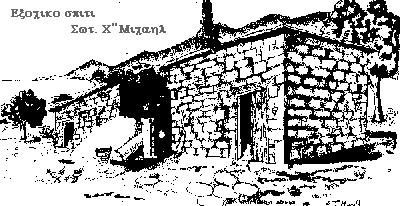|
PhgeV Nerou
Water springs
Other than the water spring of “Mana” which supplied the village for many years with water, there were other springs around the Akanthou district too:-
Stazousa(
Stazousa
):
This spring with its endless supply of water is situated on the north edges of “Trahona”. Stazousa has vournes for the animals.
The surplus water was used for the allotments of “Kalami”. Yiorkatsis had the rights to ownership of the surplus water and he owned a lot of land at “Kalami” in the 30’s of the 19th century.
Nerades(
NeradeV
):-
Here the banks of the river Manas, there are springs which are used to water local allotments.
Alakati(
Alakati
):-
Here there’s a well which was used by its owners to water their allotment.
Vrisin tou Vatou(
Brusin tou batou
):-
This is situated east of Alakati near the main road.
Vournes(
BourneV
):-
Vournes is 4-5 miles east of Akanthou about 10 acres from the sea. The water from this well was enough for the few allotments in this area.
Ais Mikallos(
AhV MikalloV
):-
Here are a few springs and wells and again they are used for the maintenance of all the allotments in the this area.
Makkouras(
MakkouraV
):-
This is another well which was used to supply water to the local vegetable fields.
Vrisin tou Tittoni(
Brusin tou Tittwnh
):-
Here my great-grandfather was using the water from the river “Helones”(note to myself:make a link to helones) to water and maintain his allotment, which was near the beach south of the main road Akanthou - Flamoudi. The origin of the water in the Helones river came from “Lagkoufos tou Karamanou”. There was a very big/deep well here.
Ta Knasa(
Ta Knasa
):-
Here there is a big well that forms the river “Gliori”.
Grousoupi(
Grousoupi
):-
Here at the base of the mountain Grousoupi there is another spring
Potos(
PotoV
):-
This is where the water from “Piperounta” ends up
Nero tis Vateris(
Nero thV BaterhV
):-
The water from here supplies the river “Skallion. This area was very green and full of life. On the edge of the river Skalion there are ruins of a flour mill that the locals of this community used for their needs. Many years ago there was a community here called “Melissa”. Maybe the “Nero tis Vateris” supplied “Melissa” with water in the early days.
Nerou tous Atous(
Nero touV AtouV
):-
This was situated along the hill tops of “Mandres”. The narrow valleys of “Piperounta” benefited from the water of Nerou tous Atous. Some 60-70 years ago the church of Akanthou had farmyards for sheep & goats.
Piyi Archangelou(
Phgh Arcaggelou
):-
Another spring which the locals took full advantage of. This was situated west of “Nerades”.
Korones(
KorwneV
):-
This spring is situated by the sea, so its water could not be used to cultivate the local allotments because the water was salty.
Yerokolymbos(
GerokolumpoV
):-

Another spring which was used to water the allotments of “Kkolounies”
Kalikrini(
Kalhgkrhnh
):-
At this location there are ruins of an ancient community. This spring is a few acres from the sea and about 6 miles west of Akanthou
Ayia Marina(
Agia Marina
):-
This is a big spring and it satisfied the needs of an ancient community. Just before the Turkish invasion of 1974 the water from this spring was used for the needs of the community of “Kalorka”. A few summer restaurants in this area made good use of the water as well. There was also a Hotel called “Glaros” and its owner Photis Christofi came from Kalorka.
Tripa tis Yerolias(
Trupa thV GeroliaV
):-
A lot of ancient communities were set up around these springs. Tripa tis Yerolias is no exception. Evidence found at the nearby communities of “Dihorka” and “Koufou” in the form of old roof tiles support this. At Dihorka there were “vournes” for animals.
The following springs are found on higher ground:
Sytzia(
Sutzia
):-
This area had allotments with orange trees
Platsies(
PlatsieV
):-
In this area there were lots of little springs which were used for the cultivation of walnut trees, apple trees, pear trees and plum trees.
Mavri Skala(
Maurh Skala
):-
The water from this source was used to drive a flour mill belonging to Pieri HadjiMihali Ellina and located at “Teratsoudkia”
Ais Yiannis(
AhV GiannhV
):-
The water from these springs was used to water allotments and run another flour mill near the road to Lefkoniko about 1.5 miles west of Akanthou
Elymbos(
ElumpoV
):-
At the top of this very high mountain top there is another spring which was the ownership of Hadjisavva Hadjiloizou
Tziefales(
TziefaleV
):-
The source of this spring puzzled the Akanthiotes. They wondered, how can water spring out from the ground so high up on the mountain. At this location there are ruins of an ancient community.
Kahoumeni(
Kacoumenh
):-
Yet another good spring. The existence of all this water around the district of Akanthou made the village so green and full of life. Today the Attila settlers who were taken there by the illegal regime of the Turkish army have renamed our village Akanthou to “
Tatlisou
” which in Turkish means sweet water. Akanthou is a piece of paradise. It has Caribbean like beaches and breathtaking scenery. We the Akanthiotes had it all, until the Turkish army invaded our Paradise and took it all away from us. We are the rightful owners of this Heaven.
I WILL NEVER FORGET MY VILLAGE NOR THOSE DARK SUMMER DAYS OF 1974.
SOONER OR LATER WE WILL RETURN TO OUR HOMELAND
|



